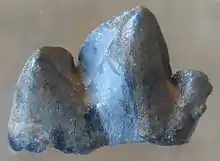Hyainailouros
Hyainailouros is an extinct genus of hyaenodont mammal of the family Hyainailouridae[1] that lived during the Miocene, of which there were at least three species spread across Europe, Africa, and Asia.[2] Closely related to other large African creodonts such as Simbakubwa and Megistotherium, Hyainailouros walked with a semi-digitigrade stance and was probably capable of large, leaping bounds.[3]
_fig._8.png.webp)
Restoration of H. sulzeri (far left), Cynelos eurydon, Afrosmilus africanus and H. napakensis (far right)
| Hyainailouros Temporal range: Miocene | |
|---|---|
 | |
| Tooth | |
| Scientific classification | |
| Kingdom: | Animalia |
| Phylum: | Chordata |
| Class: | Mammalia |
| Order: | †Hyaenodonta |
| Family: | †Hyaenodontidae |
| Subfamily: | †Hyainailourinae |
| Genus: | †Hyainailouros Biedermann, 1863 |
| Species | |
| |
Alongside its African relatives and the last members of the genus Hyaenodon from Asia, Hyainailouros was among the largest creodonts that existed.
References
- F. Solé, J. Lhuillier, M. Adaci, M. Bensalah, M. Mahboubi and R. Tabuce. 2014. The hyaenodontidans from the Gour Lazib area (?Early Eocene, Algeria): implications concerning the systematics and the origin of the Hyainailourinae and Teratodontinae. Journal of Systematic Palaeontology 12(3):303-322
- Morlo, M.; Miller, E. R.; El-Barkooky, A. N. (2007). "Creodonta and Carnivora from Wadi Moghra, Egypt". Journal of Vertebrate Paleontology. 27: 145–159. doi:10.1671/0272-4634(2007)27[145:CACFWM]2.0.CO;2.
- Borths, M. R.; Stevens, N. J. (2019). "Simbakubwa kutokaafrika, gen. et sp. nov. (Hyainailourinae, Hyaenodonta, 'Creodonta,' Mammalia), a gigantic carnivore from the earliest Miocene of Kenya". Journal of Vertebrate Paleontology. 39: e1570222. doi:10.1080/02724634.2019.1570222.
This article is issued from Wikipedia. The text is licensed under Creative Commons - Attribution - Sharealike. Additional terms may apply for the media files.